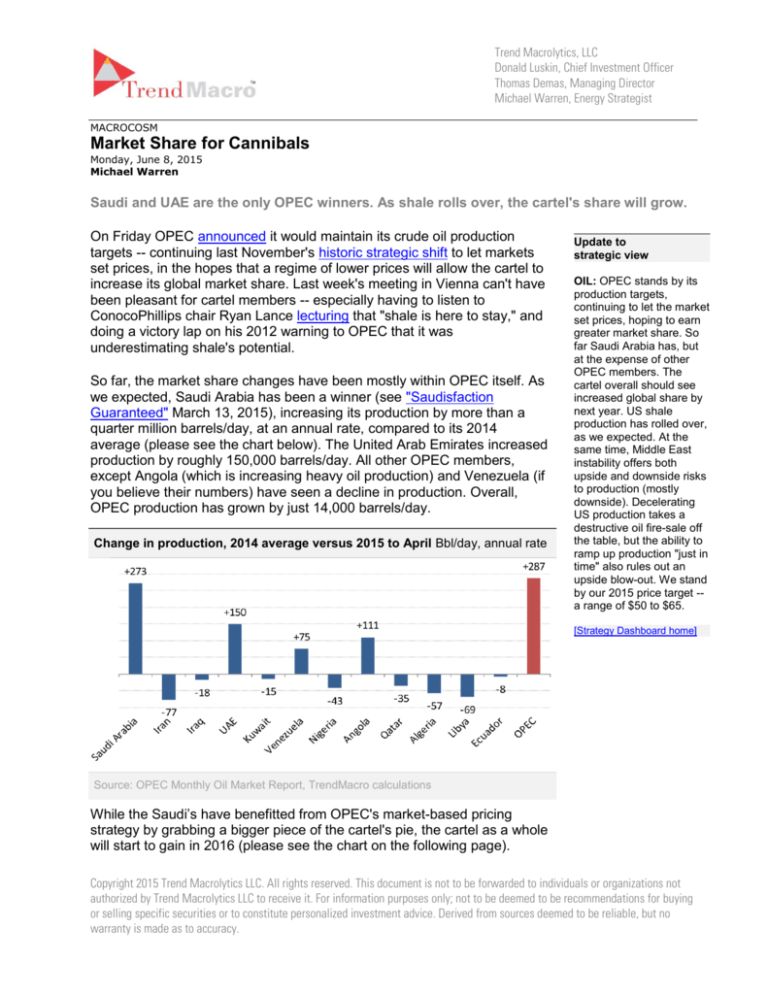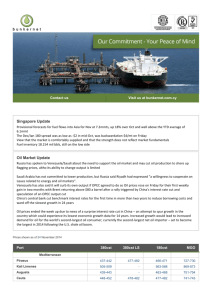
Trend Macrolytics, LLC
Donald Luskin, Chief Investment Officer
Thomas Demas, Managing Director
Michael Warren, Energy Strategist
MACROCOSM
Market Share for Cannibals
Monday, June 8, 2015
Michael Warren
Saudi and UAE are the only OPEC winners. As shale rolls over, the cartel's share will grow.
On Friday OPEC announced it would maintain its crude oil production
targets -- continuing last November's historic strategic shift to let markets
set prices, in the hopes that a regime of lower prices will allow the cartel to
increase its global market share. Last week's meeting in Vienna can't have
been pleasant for cartel members -- especially having to listen to
ConocoPhillips chair Ryan Lance lecturing that "shale is here to stay," and
doing a victory lap on his 2012 warning to OPEC that it was
underestimating shale's potential.
So far, the market share changes have been mostly within OPEC itself. As
we expected, Saudi Arabia has been a winner (see "Saudisfaction
Guaranteed" March 13, 2015), increasing its production by more than a
quarter million barrels/day, at an annual rate, compared to its 2014
average (please see the chart below). The United Arab Emirates increased
production by roughly 150,000 barrels/day. All other OPEC members,
except Angola (which is increasing heavy oil production) and Venezuela (if
you believe their numbers) have seen a decline in production. Overall,
OPEC production has grown by just 14,000 barrels/day.
Change in production, 2014 average versus 2015 to April Bbl/day, annual rate
Update to
strategic view
OIL: OPEC stands by its
production targets,
continuing to let the market
set prices, hoping to earn
greater market share. So
far Saudi Arabia has, but
at the expense of other
OPEC members. The
cartel overall should see
increased global share by
next year. US shale
production has rolled over,
as we expected. At the
same time, Middle East
instability offers both
upside and downside risks
to production (mostly
downside). Decelerating
US production takes a
destructive oil fire-sale off
the table, but the ability to
ramp up production "just in
time" also rules out an
upside blow-out. We stand
by our 2015 price target -a range of $50 to $65.
[Strategy Dashboard home]
Source: OPEC Monthly Oil Market Report, TrendMacro calculations
While the Saudi’s have benefitted from OPEC's market-based pricing
strategy by grabbing a bigger piece of the cartel's pie, the cartel as a whole
will start to gain in 2016 (please see the chart on the following page).
Copyright 2015 Trend Macrolytics LLC. All rights reserved. This document is not to be forwarded to individuals or organizations not
authorized by Trend Macrolytics LLC to receive it. For information purposes only; not to be deemed to be recommendations for buying
or selling specific securities or to constitute personalized investment advice. Derived from sources deemed to be reliable, but no
warranty is made as to accuracy.
Change in average annual oil production Thousands bbl/day
OPEC Non-OPEC — Market share
Contact
TrendMacro.Energy
On the web at
trendmacro.com
Follow us on Twitter at
twitter.com/TweetMacro
Michael Warren
Houston TX
713 893 1377
mike@trendmacro.energy
Donald Luskin
Chicago IL
312 273 6766
don@trendmacro.com
Thomas Demas
Charlotte NC
704 552 3625
tdemas@trendmacro.com
Source: OPEC Monthly Oil Market Report, TrendMacro calculations
The wide fluctuations in OPEC market share over the last five years can
be attributed to three member nations. Sanctions reduced Iranian output;
Libya’s civil war radically impacts production on a year-by-year basis; and
Iraq has been slowing building up productive capacity. While all three
countries provide upside production potential, there remains an important
downside risk: geopolitics.
Because it is so salient to US political dynamics, media commentary
tends to obsess about incursions by ISIS into Syria and Iraq. We've
long pointed to that risk (see "The Stench of CrISIS" June 25, 2014).
Late last month ISIS set ablaze the Baiji oil refinery more than 100
miles north of Baghdad, in the process of pulling out of the area they
had held since June of last year. Respectful that there are unknown
unknowns in play, our overall take is that, ironically, ISIS is a force for
regional unification -- equally threatening all established interests, and
driving closer cooperation with the US.
We are more focused on the Shia/Sunni cold war turning hot in Yemen,
pitting superpowers Saudi Arabia and Iran in what could blossom into a
full-blown regional conflict that could spill over onto innocent
bystanders. As we expected could happen (see "Oil and the Obama
Doctrine" April 10, 2015), Iranian gunboats have fired on a Singapore
tanker in the critical Straits of Hormuz, and yesterday the Saudis
reportedly shot down a scud missile fired into their territory from
Yemen.
To be sure, the flip side of these risks is that they don't materialize -resulting in greater than expected OPEC supply.
Some news reports have claimed that Iraq is ready to flood the market
with an additional 800,000 barrels/day of crude, to help OPEC squash
North American producers.
2
[About us]
Really? How is Iraq going to suddenly increase production by 800,000
barrels/day when it took the last five years to increase production by
750,000 barrels? And average production in the first four months of
2015 has been less than the average for 2014.
In reality, Iraq is signing up oil transport vessels to replace the lost
exports from the destruction of the Kirkuk-Ceyhan pipeline by ISIS
earlier this year (again, see "Saudisfaction Guaranteed"), and
redirecting barrels that used to provide the 310,000 barrels/day Baiji
refinery with feedstock. The Baiji refinery supplied Iraq with the majority
of its fuel, so Iraq will need to export oil and import gasoline and diesel
to continue to meet existing domestic demand.
Another upside risk is Libya increasing production and exports. But the
latest developments point more to a possible slowdown in production,
due to protests at the eastern port of Zueitina. Libyan 2015 production
will likely be about what it was in 2014 -- and if there is a shortfall, the
Saudis will fill it. At this time it appears that Libya is years away from
regaining the 1.5 million barrels/day production plateau that it had prior
to the overthrow of the Gaddafi regime.
Finally, the biggest upside supply wildcard is the Iranian nuclear deal.
Our opinion remains that the deal doesn’t make much sense and is
highly likely to fall apart -- but that doesn’t seem to matter to the
Obama administration (again, see "Oil and the Obama Doctrine"). With
final talks starting in earnest this month, if there is a deal, the Iranians
could add another 200,000 barrels/day (on an annual basis) to 2015
production, and much more in 2016.
Meanwhile, the Saudi strategy to let markets set prices has impacted US
CAPEX, rig counts and production. US oil and condensate production from
major light tight oil and shale formations has rolled over, as we projected in
April (please see the chart below, and again, see "Saudisfaction
Guaranteed"). Bakken production rolled over in March, and Eagle Ford
Oil and condensate production Thousands barrels/day
Source: DOE Drilling Productivity Report, TrendMacro calculations
3
production in April. While Permian Basin production is still inching higher,
its modest increase can't reverse the declines in the other major plays.
The rollover in US production from light tight oil plays means that
the nutty downside predictions heard earlier this year (see "Grant
Me $20 Oil, But Not Yet" February 17, 2015) will surely not
materialize. This spares the global economy a credit shock that
would trigger history's first recession caused by falling oil prices
(see "Houston, You're the Problem" March 9, 2015).
On the other hand, if the geopolitical risks we have pointed to
constrained global supply, the US producers have vast latent
capacity to increase production "just in time" (see "The Shale Boom
Shifts Into Higher Gear" June 1, 2015) -- production that will be
extremely profitable even at only modestly higher prices (see "I
Have Seen the Future, and It Fracks" February 24, 2015).
The combination of all these factors points back to our baseline forecast
for 2015 that global crude benchmarks will trade in a range from $50 to
$65, allowing for some speculative overshoot on both sides such as we
have already seen (see "Oilmageddon: The Sequel" January 15, 2015).
Bottom line
OPEC stands by its production targets, continuing to let the market set
prices, hoping to earn greater market share. So far Saudi Arabia has, but
at the expense of other OPEC members. The cartel overall should see
increased global share by next year. US shale production has rolled over,
as we expected. At the same time, Middle East instability offers both
upside and downside risks to production (mostly downside). Decelerating
US production takes a destructive oil fire-sale off the table, but the ability to
ramp up production "just in time" also rules out an upside blow-out. We
stand by our 2015 price target -- a range of $50 to $65.
4







